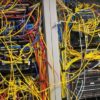Dynamic Routing
These protocols can dynamically respond to changes in the network. The routing protocol is configured on each router and the routers learn about both each other and remote networks.
Examples of modern dynamic routing protocols include:
• RIP v1,2 (ok, maybe this isn’t very “modern”)
• EIGRP
• IS-IS
• OSPF
• BGP
Distance Vector vs. Link-State
Distance Vector
When routers run a distance vector dynamic routing protocol, they periodically send information about their known routes to their connected neighbors. This is how the router knows whether changes have been made to the network. They compare their routing table against the information they receive from their neighbors – if it matches, they’re good. If not, they update their routing tables to reflect the changes.
RIP is an example of a distance vector routing protocol.
Link State
Link state routing protocols operate differently. Routers send information about the state of their links to the entire network (or area) that they are a part of. In this way, each router understands the entire network topology and must run an algorithm every time a network change is announced to recalculate the best routes throughout the network. This makes link state routing protocols much more processor intensive.
The second major difference in link state routing protocols is that updates are only sent if a change on a router’s link occurs. This helps keep bandwidth utilization low, unlike distance vector protocols which send out reoccurring updates regardless if a change has occurred.
OSPF and IS-IS are examples of link state routing protocols.
Advanced Distance Vector
Advanced distance vector is the title Cisco gives to EIGRP, which borrows the best attributes of both distance vector and link state designs. EIGRP does not send periodic route information; instead it sends updates only when changes occur (like link state protocols). Also, EIGRP forms neighbor relationships with its directly connected peers and only updates them – not the entire network (like distance vector protocols).
If you would like help with the Cisco Route 300-101 prep or any other Cisco exam, I offer a mentor program. Get in touch to find out more.

Pingback: Effortlessly Configure OSPF with Cisco Setup – clifford network